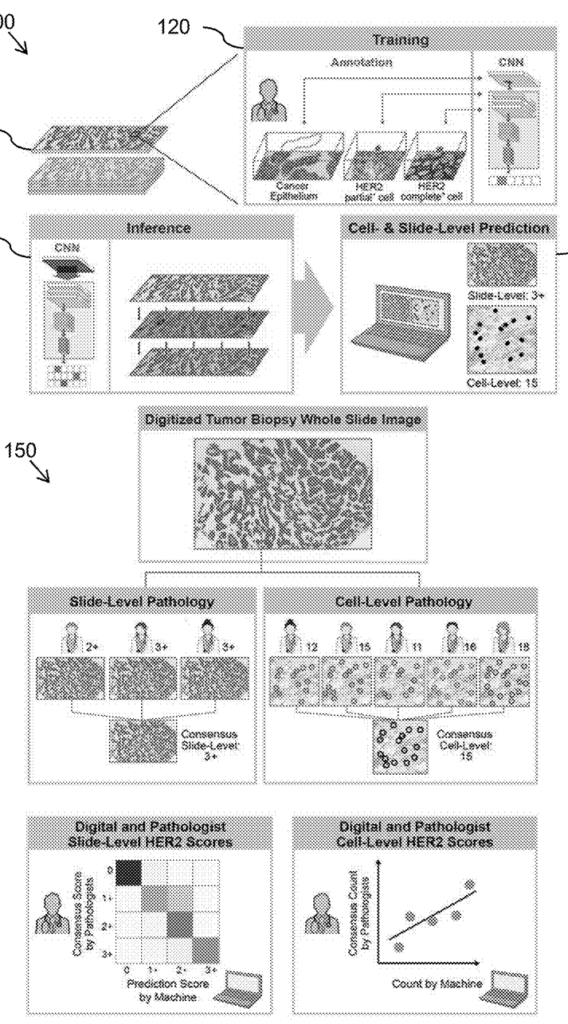Artificial intelligence is revolutionizing healthcare, and PathAI stands at the forefront of this transformation. By significantly improving the accuracy and speed of medical diagnoses, PathAI’s innovative patents are setting new standards in the industry. Recently, PathAI unveiled a major update to its AI diagnostic system, highlighting remarkable advancements in pathology analysis. This breakthrough promises to enhance patient care and make early detection and treatment more accessible. This article explores PathAI’s transformative patents and the future of AI in healthcare diagnosis.

How will PathAI’s system in Healthcare Diagnostics function?
- Data Collection: AI systems collect and analyze vast amounts of medical data, including patient records, medical images, and test results.
- Data Processing: Advanced algorithms process this data to identify patterns, anomalies, and correlations that may not be visible to the human eye.
- Model Training: Machine learning models are trained using labeled datasets, where known diagnoses are used to teach the AI how to recognize and predict diseases.
- Pattern Recognition: AI systems use pattern recognition techniques to detect abnormalities in medical images, such as X-rays or MRIs, and identify potential health issues.
- Predictive Analysis: AI tools analyze historical data to predict patient outcomes and potential risks, enabling early intervention and personalized treatment plans.
- Decision Support: AI provides decision support to healthcare professionals by suggesting potential diagnoses and treatment options based on the analyzed data.
- Continuous Learning: AI systems continuously learn from new data and outcomes, improving their accuracy and diagnostic capabilities over time.
Key Patents for PathAI’s on AI in Healthcare Diagnosis:
We’ve analyzed key patents related to AI in Healthcare Diagnosis. Read the summary below and discover the ingenious innovations behind this breakthrough technology!
The patent, US20240153616A1, introduces a cutting-edge method using a machine learning (ML) model to annotate pathology slide images with exceptional accuracy. This model, trained on images from various modalities like multispectral imaging (MSI), polarization imaging, and quantitative phase imaging, significantly enhances detail and precision beyond what conventional whole-slide imaging (WSI) can achieve. This innovation enables more precise and detailed diagnostic annotations, setting a new standard in medical diagnostics.
The patent US20220245802A1 outlines a cutting-edge method for classifying biomedical images using graph neural networks. The process involves:
- Generating Annotations: Creating annotated representations of the biomedical images.
- Clustering Pixels: Identifying clusters of pixels within the image.
- Constructing Graphs: Building a graph based on these pixel clusters.
- Determining Features: Assessing biomedical features for graph nodes from the annotations.
- Classifying Data: Utilizing the graph neural network to classify the image data based on these features.
This innovative approach enhances diagnostic accuracy by leveraging advanced AI techniques to analyze complex biomedical images.
The patent US20220375606A1 outlines advanced techniques for AI-based diagnostic assessments using digital pathology data. Here’s a summary of its innovative approach:
- Data Collection: The system acquires digital pathology data, capturing intensity information from various regions within a biological sample.
- Analysis: Initial machine learning models identify key regions of interest, while subsequent models detect patterns within these areas.
- Diagnostic Assessment: The technology generates a diagnostic evaluation based on the identified regions and detected patterns.
PathAI’s innovative system is set to transform healthcare diagnosis, offering unmatched precision and efficiency. While notable projects like IBM Watson Health, Google’s DeepMind Health, and Zebra Medical Vision have made significant advances, PathAI stands out with its unique approach that combines advanced algorithms with rigorous clinical testing. This ensures the highest levels of accuracy and reliability. By enhancing diagnostic capabilities and making quality healthcare accessible to more people, PathAI is bridging critical gaps, particularly in underserved regions. As we enter a new era in medical diagnostics, it’s worth considering: how will AI continue to shape the future of healthcare, and what other ground-breaking advancements lie ahead?
Need to know anything else? We got you covered!




